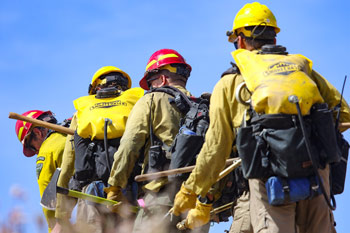Click Here for California Fires
July 11, 2024 - Wildfire activity continues to escalate due to extremely hot and dry conditions in many areas. Right now, 74 large active wildfires are being managed  nationwide, and have burned 681,569 acres. Fire managers are using full suppression strategies on 33 of these wildfires. More than 14,400 wildland firefighters and support personnel are assigned to incidents across the nation.
nationwide, and have burned 681,569 acres. Fire managers are using full suppression strategies on 33 of these wildfires. More than 14,400 wildland firefighters and support personnel are assigned to incidents across the nation.
Yesterday the Great Basin Coordination Center's predictive services staff issued three fuels and fire behavior advisories for Nevada, Southern Idaho and Utah and Arizona Strip. Each advisory lists unique concerns, however, there are some commonalities. All of these areas have a lot of fine fuels and both dead and live fuels are drying rapidly due to recent record temperatures. These conditions, coupled with the hot temperatures and dry conditions, are affecting the fire behavior in these areas. There is a fuels and fire behavior advisory still in effect for California that highlights abnormally high fine fuel loading across the state. Residents, travelers, or workers on their way to any of these states should be advised and familiarize themselves with the elevated risks.
The national predictive services staff at the National Interagency Coordination Center released the National Significant Wildland Fire Potential Outlook for July through October. For additional information about the current outlook visit the Outlook page on the NICC site.
If you live in a fire-prone area, especially if your home is adjacent to wildlands, take some steps to make your home more defensible if wildfire should come your way. Create fire breaks with lawns, driveways and walkways and stack firewood away from your home. Make sure your address is visible from the road so emergency responders can see it. Ensure you have a plan for your family and pets to evacuate when needed. Now is the time to make sure you are ready for a wildfire. Check out these sites to help you prepare: https://www.ready.gov/wildfires and https://www.readyforwildfire.org/.
Strong high pressure aloft will slowly shift eastward over the central Great Basin with widespread record- challenging heat continuing across much of the Intermountain West and expanding into the northern High Plains. Very low afternoon relative humidity of 5-20% will persist for the northern two-thirds of the Intermountain West with some locations in the Great Basin dropping into the low single digits. Breezy westerly sustained winds of 12-20 mph gusting between 20-35 mph are likely across much of eastern Oregon, the east slopes of the Sierra, northern Great Basin into western Wyoming, and near the Divide in Montana. Moisture will slowly spread a little farther north and westward in the Southwest with isolated to scattered thunderstorms turning wetter for southeast Arizona into much of New Mexico and south-central Colorado, while isolated mixed wet and dry thunderstorms are likely along the western Mogollon Rim to the Arizona Strip and along the West Slope. Isolated dry thunderstorms are also possible from the east slopes of the Sierra south of Tahoe into central Nevada, with isolated mixed wet and dry thunderstorms near and east of the Divide in Montana. Isolated to scattered showers and thunderstorms will develop from north Texas and Oklahoma into the Great Lakes, while a weak tropical wave moving along the East Coast brings moderate to heavy rain to eastern North Carolina and Virginia. Scattered showers and thunderstorms are expected along the Gulf Coast into Florida as well. Cool and wet conditions are expected in western Alaska, with seasonable and dry weather forecast for the eastern Interior. National Predictive Services Outlook 6 Minutes for Safety: The 6 Minutes for Safety topic of the day is Power Line Safety.
| Number of new large fires or emergency response * New fires are identified with an asterisk |
8 | States currently reporting large fires: |
| Number of active large fires Total does not include individual fires within complexes. |
74 | |
| Acres from active fires | 681,569 | |
| Fires contained | 5 |
Year-to-date statistics
| 2024 (1/1/24-7/11/24) | Fires: 23,676 | Acres: 2,901,393 |
| 2023 (1/1/23-7/11/23) | Fires: 25,974 | Acres: 739,913 |
| 2022 (1/1/22-7/11/22) | Fires: 0 | Acres: 5,021,894 |
| 2021 (1/1/21-7/11/21) | Fires: 33,491 | Acres: 1,868,143 |
| 2020 (1/1/20-7/11/20) | Fires: 27,253 | Acres: 1,650,984 |
| 2019 (1/1/19-7/11/19) | Fires: 22,004 | Acres: 1,953,652 |
| 2018 (1/1/18-7/11/18) | Fires: 32,568 | Acres: 3,307,535 |
| 2017 (1/1/17-7/11/17) | Fires: 33,430 | Acres: 3,760,090 |
| 2016 (1/1/16-7/11/16) | Fires: 28,496 | Acres: 2,364,900 |
| 2015 (1/1/15-7/11/15) | Fires: 30,678 | Acres: 4,540,739 |
| 2014 (1/1/14-7/11/14) | Fires: 28,618 | Acres: 992,172 |
10-year average Year-to-Date
| 2014-2023 | Fires: 29,597 | Acres: 2,551,290 |
Source: NIFC








